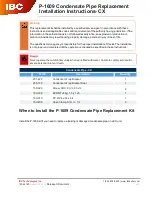
IMPORTANT: Turn off the gas supply and electrically isolate
the appliance before replacing any components.
NOTE: Turning the control knob fully anti-clockwise does not
isolate the appliance electrically.
After the replacement of any components always check for gas
soundness where relevant and carry out functional checks as
described in Section 13-Commissioning.
Complete gasket and O-ring packs are available for gas and
water connections on the appliance.
DHW Circuit:
Turn off the mains cold water supply at the
appliance. Refer to Fig. 13. Open a hot tap below the level of the
Component Access
Refer to Section 15, Inspection and Servicing for access to
components.
Draining the Appliance
Primary System: Turn off the heating flow and return valves at
the appliance. Refer to Fig. 13.
Open the drain tap. Fit a tube to the drain tap. Refer to Fig. 45.
Close the drain tap when the flow from the appliance has
stopped.
appliance to drain the domestic hot water from the appliance.
Important: A small quantity of water will remain in some
components even after the appliance has been drained.
Protect any electrical components when removing items from
the water circuits.
NOTE: After re-opening the mains cold water inlet valve, draw
off a little water from a tap to ensure that there is water in the
heat exchanger.
Component Replacement
Refer to Fig. 41 and 46 for an indication of the location of the
various components.
Replace any components removed from the appliance in the
reverse order using new gaskets/O-rings/sealant/heat transfer
paste where necessary. Always check that any electrical
connections are correctly made and that all screws are tight.
Remove casing and cover panels and lower the facia onto lower
lugs, as necessary, to gain access to the components. Refer to
Section 15, Inspection and Servicing.
1 Gas Valve
Remove the burner assembly as described in Section 15.4.
Carefully pull-off the electrical connections to the valve.
Remove the injector and copper washer.
Remove the two screws securing the manifold at the rear of the
combustion chamber.
Unscrew the union connection beneath the valve and ease the
valve and injector manifold from the boiler.
Use new gaskets when replacing the valve.
Do not forget to replace the burner injector and copper
washer.
Set the Gas Valve:
Connect a pressure gauge to the burner and inlet pressure test
points on the valve. Refer to Fig. 35.
Switch on the gas and electricity supplies.
Check for gas tightness at the gas valve inlet.
Refer to Section 13-Commissioning, for the method of checking
the pressures.
Check for gas soundness at the gas valve outlet.
Adjust the maximum and start pressure [minimum], as necessary,
to obtain the required pressures.
Switch off the appliance and disconnect the pressure gauge and
tighten the screw.
Check for gas soundness at the test point.
To set the burner pressure.
Refer to Fig. 35.
The minimum and maximum burner pressures must be set after
a new gas control has been fitted.
Only slight adjustment is required to change pressure.
Follow the procedure described in Section 13 - Commissioning.
The maximum burner pressure must be set first, as any
adjustment of the maximum pressure influences the minimum
pressure setting.
Start the appliance in the domestic hot water mode as described
in Section 13.8. - Appliance Operation.
Turn the gas valve mode switch to maximum. Refer to Fig. 36.
Adjust the maximum pressure adjustment screw on the gas
valve to give a burner pressure of 13.6 mbar (24i), 14.7mbar (28i)
for natural gas.
For propane, the maximum pressure adjustment screw should
be adjusted to give a pressure of 35.3mbar (28i).
Turn the gas valve mode switch to minimum.
Adjust the start pressure adjustment screw on the gas valve to
give a pressure of 1.4mbar (24i), 1.2mbar (28i) for natural gas or
3.4mbar (28i), 4.6mbar (24i) for propane.
Turn the gas valve mode switch back to normal.
After completing the adjustments, check the minimum and
maximum pressures and re-adjust as necessary.
16. Replacement Of Parts
25
Fig. 46 . Lower casing - gas and water
controls.
9
6
8
5
1
3
2
1. Gas valve
2. Pump
3. Pressure gauge
4. Relief valve
5. Manifold assembly
6. DHW sensor
Fig. 45 . Boiler drain point.
7
7. DHW flow turbine
8. Filling loop assembly
(optional extra)
9. CH sensor
10. Pump clip
1. Pump head
2. Boiler drain point
3. Flexible hose to expansion vessel
connection
4. O-ring
2
3
4
1
4
10
















































